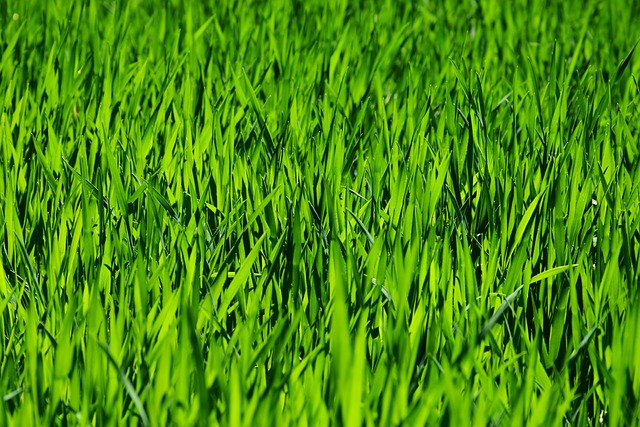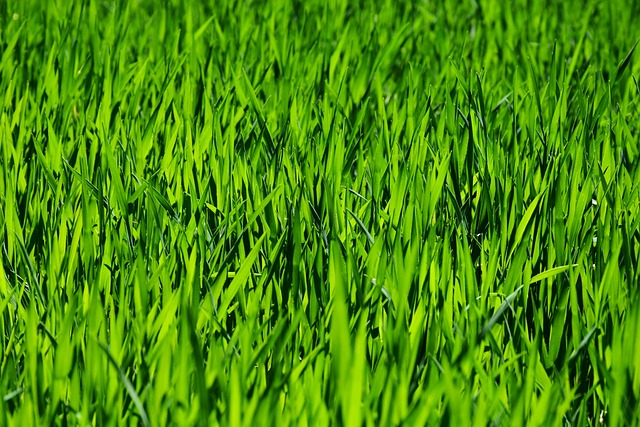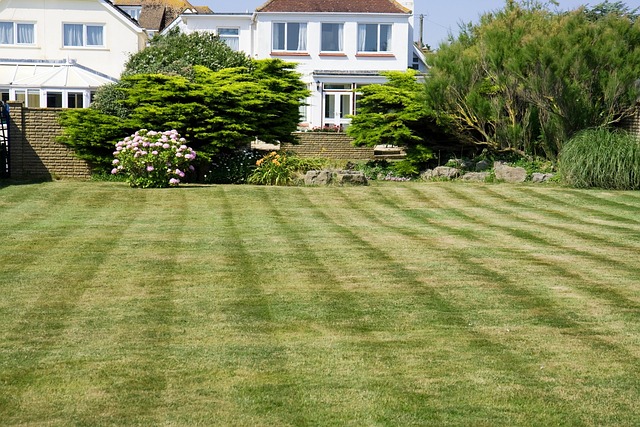Effective lawn care and landscaping are essential for maintaining a thriving, visually appealing outdoor space throughout the year. Key practices include mowing at the correct height for your grass species to promote root growth and a dense turf that naturally deters weeds. Aeration should be performed to prevent soil compaction, and strategic fertilization, applied according to the grass's growth cycle, enhances growth and disease resistance. Overseeding can address bare patches, increasing the lawn's resilience against weeds and pests. Watering should be deep and infrequent to encourage robust root systems. Landscaping with a variety of textures, colors, and plant species creates a harmonious environment that complements your home's architectural style and includes focal points for visual appeal. Integrating hardscape elements like paths or patios adds functionality and aesthetic value. Seasonal lawn care tailored to local conditions ensures health and vibrancy; in spring, focus on clearing debris, aeration, and fertilization, while summer demands consistent irrigation and mulching to preserve moisture. In autumn, reduce fertilization to prevent frost damage, manage fallen leaves for soil enrichment, and in winter, protect plants and plant cover crops. By adhering to these seasonal strategies and regularly monitoring your landscape, you can achieve a resilient garden ecosystem that remains vibrant all year long, emphasizing the importance of lawn care and landscaping for home aesthetics and outdoor living experiences.
Embark on a journey to transform your outdoor oasis into a thriving haven with our comprehensive guide on Garden Maintenance and Beautification. Discover essential strategies for optimal lawn care, such as mastering the art of soil management and watering techniques that will enhance your yard’s vigor. Explore landscaping fundamentals that will help you design an aesthetically pleasing outdoor space. And, with our seasonal maintenance tips, ensure your garden remains lush and colorful throughout the year. Dive into Lawn Care and Landscaping to elevate your green space and create a sanctuary of beauty and tranquility.
- Strategies for Optimal Lawn Care: Enhancing Your Yard's Vigor
- Landscaping Essentials: Designing a Visually Stimulating Outdoor Space
- Seasonal Maintenance Tips: Keeping Your Garden Lush and Colorful Year-Round
Strategies for Optimal Lawn Care: Enhancing Your Yard's Vigor

Maintaining a lush, vibrant lawn requires a combination of consistent care and strategic planning in landscaping. The foundation of optimal lawn care lies in understanding the specific needs of your turf grass, including the type of grass that dominates your yard. Regular mowing at the correct height, tailored to the species of grass, encourages healthy root growth and a denser turf, effectively crowding out weeds. Aeration is another crucial practice; it allows air, water, and nutrients to penetrate the soil, reaching the roots more efficiently. This process not only improves soil health but also reduces the likelihood of compacted soil, which can suffocate grass roots.
In addition to regular mowing and aeration, fertilization is key to lawn care and landscaping. A well-timed and balanced fertilizer regimen supports robust growth and disease resistance. It’s important to follow a schedule that aligns with the growth patterns of your grass; applying nutrients at the right time ensures they are utilized effectively, rather than being wasted or leached away. Additionally, overseeding bare spots can thicken your lawn and provide a protective barrier against weeds and pests. Watering strategies should be tailored to your local climate and weather conditions, focusing on deep, infrequent watering to promote strong root systems. By integrating these lawn care practices into your landscaping routine, you’ll enhance your yard’s vigor, creating an inviting and healthy outdoor space.
Landscaping Essentials: Designing a Visually Stimulating Outdoor Space

Engaging in lawn care and landscaping can significantly enhance the aesthetic appeal and functionality of your outdoor space. A well-designed landscape not only adds visual stimulation but also creates a harmonious environment that complements the architectural style of your home. To achieve this, consider integrating a variety of textures, colors, and plant species into your design. The use of contrasting elements, such as a mix of flowering plants with evergreens, can provide year-round interest and resilience in your garden. Strategic placement of these elements can also draw the eye and create focal points that are pleasing to the beholder.
When planning your landscape, prioritize the health and growth of your grass by employing effective lawn care practices. Regular mowing, watering, and fertilization tailored to your local climate and soil conditions are essential for a lush, green lawn. Additionally, incorporating garden beds with a diverse array of perennials and annuals can add seasonal variation and color to your landscape. The integration of hardscape elements like paths, patios, or water features can further enhance the space, providing structure and interest while also serving practical purposes. By thoughtfully combining these landscaping essentials, you can design an outdoor space that is both beautiful and inviting, offering a tranquil retreat from the hustle and bustle of daily life.
Seasonal Maintenance Tips: Keeping Your Garden Lush and Colorful Year-Round

Engaging in seasonal lawn care and landscaping ensures your garden remains lush and colorful throughout the year. As seasons transition, plants have varying needs to thrive; understanding these requirements is key. In spring, focus on removing winter debris, aerating the soil to allow water and nutrients to reach the grass roots, and applying a balanced fertilizer to promote healthy growth. Regular mowing at the highest blade setting helps prevent weed seed germination and allows grass blades to grow strong. Come summer, maintain consistent irrigation to counteract the effects of high temperatures and ensure plants receive sufficient moisture without waterlogging the soil. Mulching garden beds can conserve soil moisture, suppress weeds, and improve soil quality. As autumn approaches, reduce fertilization to prevent late-season growth that could be damaged by early frosts. Rake and compost fallen leaves to enrich the soil for next season. Finally, in winter, protect tender plants from cold damage and consider planting cover crops to enhance soil health and prepare for spring. By adhering to these seasonal lawn care and landscaping practices, your garden will continue to be a vibrant, welcoming space regardless of the calendar’s page. Regular observation and timely intervention are crucial for maintaining a healthy, diverse garden ecosystem all year long.
In conclusion, maintaining a thriving lawn and designing an inviting outdoor space are key components of lawn care and landscaping that contribute significantly to the aesthetic appeal of your property. By implementing the strategies outlined in “Strategies for Optimal Lawn Care: Enhancing Your Yard’s Vigor,” and incorporating the essentials detailed in “Landscaping Essentials: Designing a Visually Stimulating Outdoor Space,” homeowners can create a lush, vibrant environment that thrives throughout the seasons. The seasonal maintenance tips provided in “Seasonal Maintenance Tips: Keeping Your Garden Lush and Colorful Year-Round” further ensure that your garden remains a source of beauty and tranquility regardless of the time of year. With dedication to these practices, your lawn and landscape will not only reflect your personal style but also provide a serene retreat for you to enjoy.
